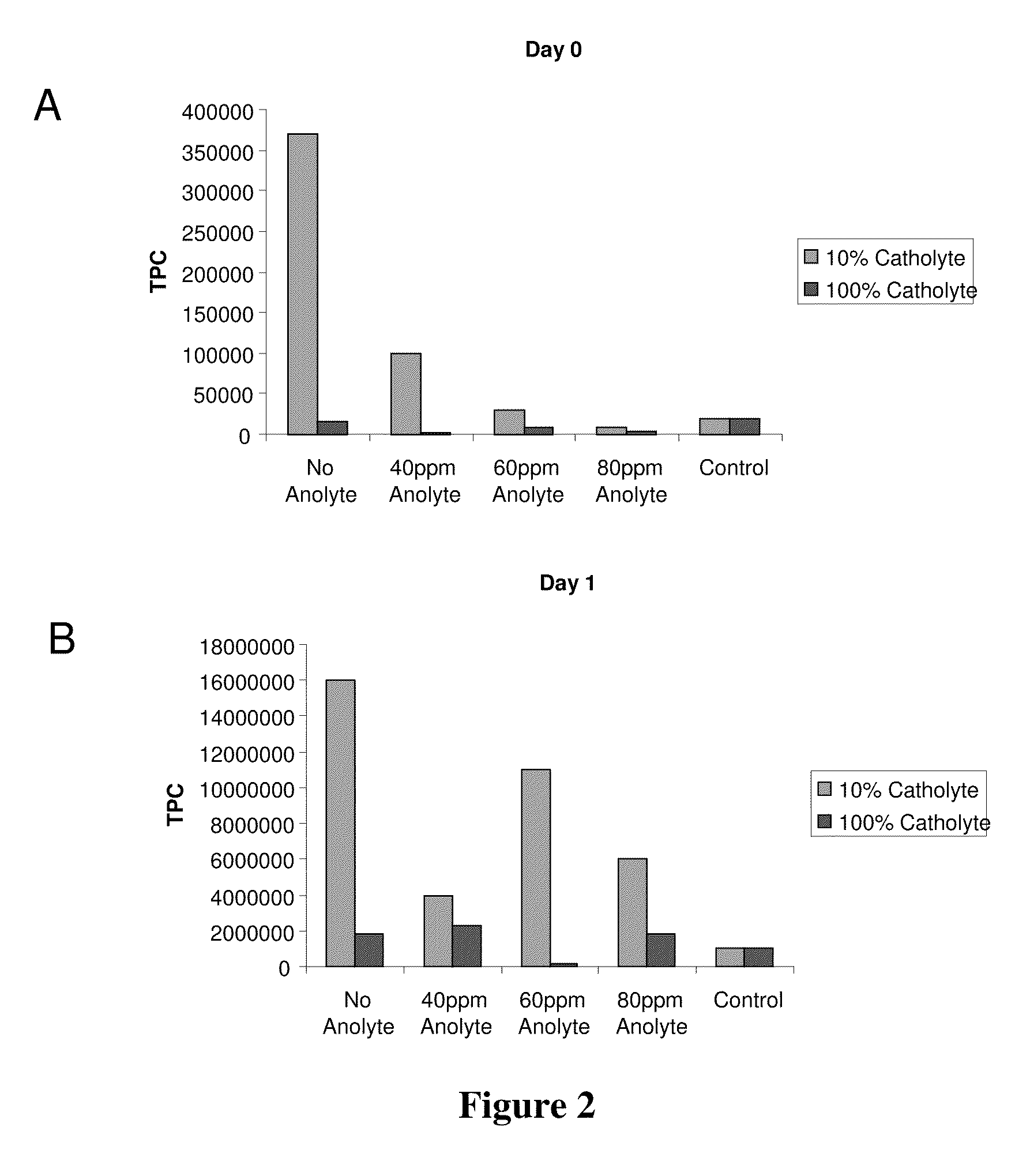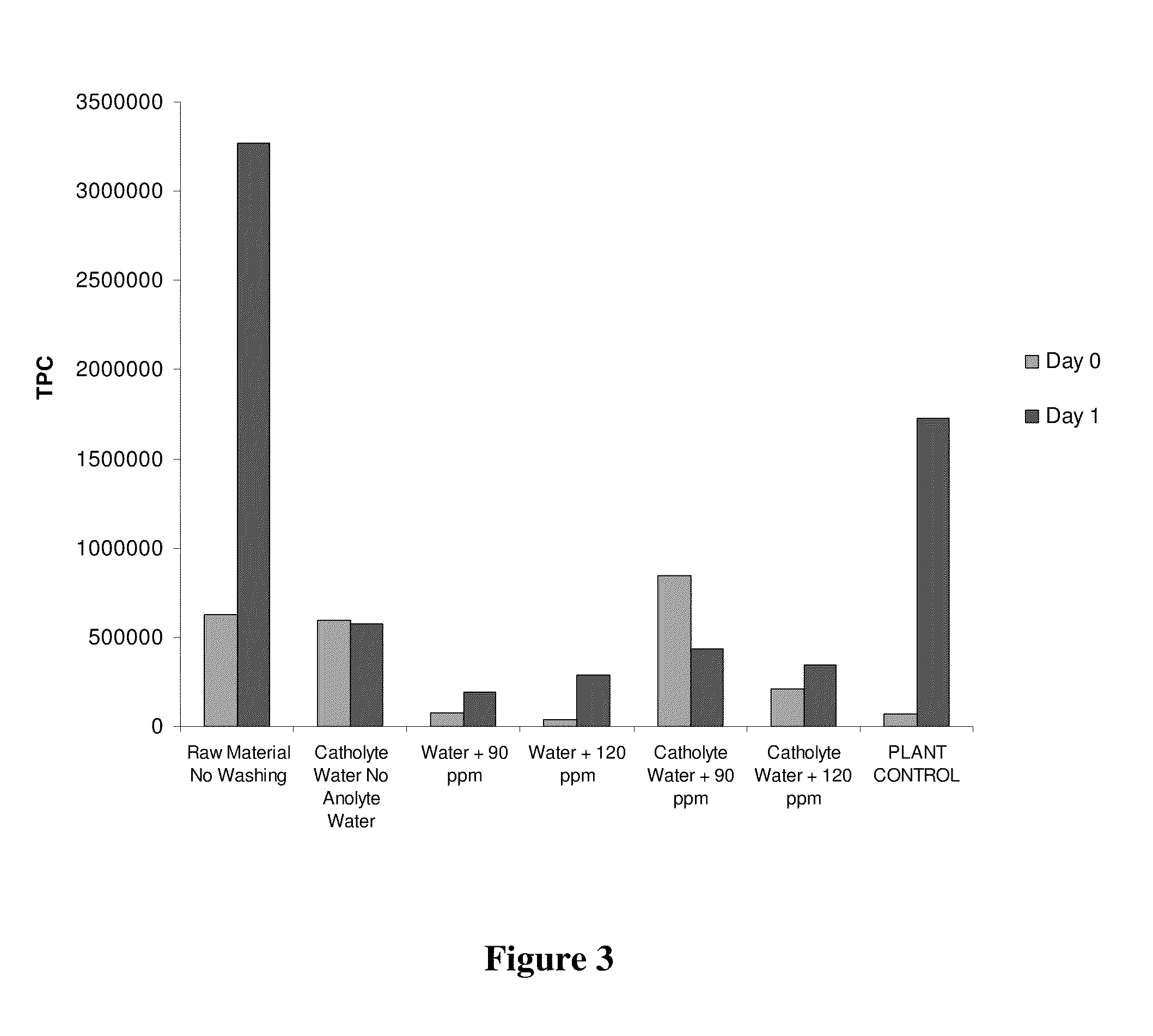Tandem Use of Catholyte and Anolyte to Clean and Sanitize Fruit and Vegetables
- Summary
- Abstract
- Description
- Claims
- Application Information
AI Technical Summary
Benefits of technology
Problems solved by technology
Method used
Image
Examples
example 1
Disinfecting Produce by Treating with Anolyte Solution
Introduction
[0055]The following experiments evaluate anolyte as a successful disinfecting solution for leafy vegetables, specifically tender lettuces. While neither pathogen monitoring nor pathogen spiking was performed, a significant reduction in total aerobic load is expected to reduce pathogen loads, as most pathogens are more sensitive to such sanitizers than their non-pathogen competitors. Food borne infections are a result of ingesting a sufficient load of the pathogen in order to induce illness. Similarly, food intoxications arise from a sufficient production of toxins from a load of toxin-producing pathogens. The reduction of these pathogenic loads will reduce the total overall risk of food borne infection.
[0056]A preliminary study indicated the value of such treatments. While initial microbial loads were reduced to almost zero, there was some indication of irritation or topical damage to the vegetables tested as measured...
example 2
De-Soiling and Disinfecting Produce by Sequentially Treating with Catholyte and Anolyte Solutions
[0066]The catholyte solution produced from the electrolysis of brine solution was used as a de-soiling agent. The following experiments test the validity of using the catholyte as a de-soiling solution for fresh vegetables. The ability to remove soil and biofilms from vegetables was assessed using turbidity measurements. A greater turbidity is an indication of the ability of the catholyte treatment to de-soil the vegetables. Undiluted catholyte solution was compared to several dilutions. A non-ionic surfactant (i.e. dishwashing detergent) was used as a positive control. Fresh water from the tap was used as the negative control. In addition, the catholyte treated samples were subjected to ultrasonication treatment to identify its effectiveness in loosening and removing additional soil and biofilm from the vegetables. Once an effective dilution was identified, the vegetables were treated w...
example 3
Second Test of Treating with Catholyte and Anolyte Solutions to De-Soil and Disinfect Produce
Introduction
[0081]The tandem catholyte and anolyte treatment of fresh vegetable samples was repeated using a 10% catholyte dilution and anolyte at concentrations of either 90 ppm FAC or 120 ppm FAC. The method used for these trials was the same as that followed for Example 2 above.
Results and Discussion
[0082]As shown in FIG. 3 use of anolyte solution at either 90 ppm or 120 ppm FAC reduced the microbial load by about one log unit when compared to the no wash control at day 0. However, using anolyte at either 90 ppm or 120 ppm FAC gives about a one log unit reduction in microbial load compared to the no wash control 24 hours post packaging. These results demonstrate that increasing the concentration of anolyte from 80 ppm to at least 90 ppm FAC provides a reduction in microbial load after 24 hours (comparing FIG. 2B to FIG. 3).
PUM
| Property | Measurement | Unit |
|---|---|---|
| Fraction | aaaaa | aaaaa |
| Fraction | aaaaa | aaaaa |
| Fraction | aaaaa | aaaaa |
Abstract
Description
Claims
Application Information
 Login to View More
Login to View More - Generate Ideas
- Intellectual Property
- Life Sciences
- Materials
- Tech Scout
- Unparalleled Data Quality
- Higher Quality Content
- 60% Fewer Hallucinations
Browse by: Latest US Patents, China's latest patents, Technical Efficacy Thesaurus, Application Domain, Technology Topic, Popular Technical Reports.
© 2025 PatSnap. All rights reserved.Legal|Privacy policy|Modern Slavery Act Transparency Statement|Sitemap|About US| Contact US: help@patsnap.com



